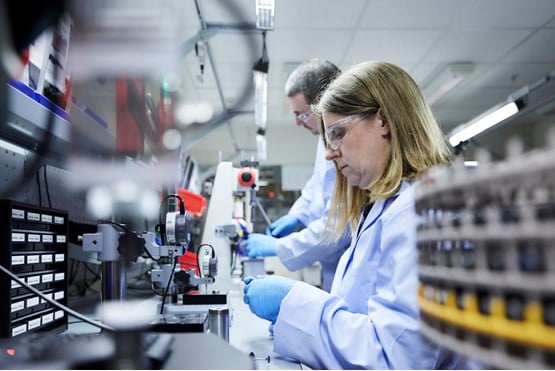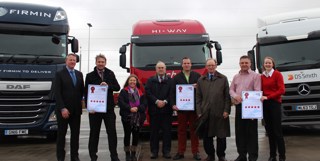If you want to get an idea of the direction vans and trucks are likely to head in over the next few years, don’t just look at what the manufacturers are doing and saying. Take a look at the activities of some of the industry’s leading original equipment (OE) components suppliers.
Manufacturers are, after all, largely assemblers of items made by other people; and they rely heavily on the technologies key suppliers are continually working on.
Diesel’s obituary has been written way too soon, says Mary Gustanski, chief technology officer at Delphi Technologies.
Detailed developments in everything from fuel injection to electronic controllers for engines mean the fuel still has plenty of life left in it for commercial vehicles.

It will not be completely displaced by battery-only power any time soon, especially for long-distance transport.
Battery power may be a valid option if you are using vans on short-haul last-mile work, delivering parcels and packages in urban areas.
“However, running a 44-tonne truck purely on batteries is difficult at present if you want it to move any goods,” says Dave OudeNijeweme, head of technology trends at the Advanced Propulsion Centre, a collaborative project between government and industry.
He was the keynote speaker at a recent press event hosted by Delphi.
The sheer weight of the battery pack – 11 tonnes or more according to some industry estimates – would steal a large chunk of its payload capacity.
Battery power densities are likely to increase significantly between now and 2035, he concedes. This will involve moving away from lithium-ion to other types of battery technology.
“I’m thinking here of solid state, but if you are going to introduce solid state batteries you’ve got to move them out of the laboratory and into mass production,” he says.
One route manufacturers might pursue, OudeNijeweme suggests, is to employ a mixture of batteries and ultra-capacitors. The latter have limited energy storage capacity, but can deliver large power boosts if a heavily-laden truck needs help climbing a steep incline.
Battery makers will certainly need to eliminate some of the rare earth materials they use, he suggests; or attempt to recycle them. “They are expensive, and a lot of them come from China,” he says.
Becoming too reliant on a single source of materials needed to make a vitally-important product can leave an industry a hostage to fortune.
In the meantime, the innovations Gustanski is thinking of should ensure that diesel engines operate more efficiently, emitting less CO2 and NOx. Odds are, however, that they will be incorporated into diesel-electric hybrid powertrains.
“Some 90% of the vehicles sold worldwide in 2030 will still have an engine,” Gustanski says.
“I expect 50% will be electrified, but the bulk of them will be hybrids. High-voltage hybrid solutions will be the technology of choice.”
Delphi powertrain electrification expert Joel Durr says: “A 48v mild hybrid can reduce CO2 output by 15% compared with a standard diesel engine.”
Opt for a plug-in hybrid and CO2 will fall 50%, he adds.
The advantage of going the hybrid route is the ability to combine diesel’s efficiency benefits on long-haul runs with the ability – dependent on the hybrid technology selected – to switch to zero-emission, battery-only power in restricted urban areas.
A development that will have a significant role to play, says Gustanski, is Delphi’s launch of a remarkable ultra-high-precision fuel injector for truck engines, with a valve that is just 1mm in diameter.
In pilot production at the company’s plant in Stonehouse, Gloucestershire, it is being made using miniaturised manufacturing techniques that involve sub-micron clearances. They go beyond the tolerances required by the aerospace industry, says the company.
The DFI 21 injector is at the heart of Delphi’s new F3 common rail injection system. Announced as a development concept in 2016, it will enter volume production in 2021 following business wins in Europe and the USA.

The extraordinarily-low weight of the 1mm valve helps the DFI 21 deliver up to nine injections per combustion cycle compared with three for a typical Euro 6 system. Benefits include less soot and less NOx; and if less NOx is being emitted, then AdBlue consumption could fall.
“Reducing engine-out emissions gives engine designers much greater flexibility in their after-treatment strategy, with some significant potential cost savings for both the vehicle manufacturer and the operator,” says Delphi product engineering director James Kewley.
“DFI 21 could allow simplification of exhaust after-treatment and a reduction in Selective Catalytic Reduction (SCR) fluid consumption.”
Nor will DFI 21’s performance get sloppy as it grows older, he stresses. That is because the F3 system uses something called closed-loop compensation.
It ensures the injectors will remain accurate throughout an engine’s typical design life of around a million miles.
The unique performance signature of each of the DFI 21 injectors is coded onto a chip within the injector which communicates with the ECU (engine control unit), enabling it to adjust each pulse. This compensates for any change in the injector’s characteristics over time.
Kewley makes the point that Delphi’s approach to closed-loop control means no extra wiring is required.
“This will significantly reduce the cost and the manufacturing and packaging penalties usually associated with the introduction of closed-loop sensing,” he says. “It’s a great example of our ‘clever, not complex’ design philosophy.”
Introducing more sophisticated injectors appeals to vehicle manufacturers because it means they can garner significant performance improvements without having to engage in major engine redesigns.
“Even a minor redesign can cost millions,” Gustanski says.
Delphi is also working on 400v and 800v electrical systems with high-voltage power switches for commercial vehicles, not to mention sophisticated electronic powertrain controllers.
Due to go into production from 2020 onwards, its Generation 7 controller includes the cybersecurity protection necessary to enable vehicle manufacturers to deliver over-the-air software updates that allow system upgrades to be delivered overnight – without interrupting the van or truck’s servicing schedule.
There remains plenty of further scope for improving the efficiency of diesel engines thereby lessening their CO2 emissions and overall environmental impact, says OudeNijeweme.
“I’m thinking of waste heat recovery systems from the engine’s multiple heat sources and the use of synthetic fuels, including fuel from waste,” he says.
Gaseous fuels remain an option and one that is being embraced by a small, but growing, number of operators. Methane slip remains a concern – “from the emissions viewpoint that can make gas worse than diesel,” he says – and if you power your vehicles with liquefied natural gas you will find you are competing for it with major industrial users. “Industry will still want its share,” he says.
Other developments are, of course, occurring in line with powertrain changes. “By 2022/2023 anywhere between 70% and 80% of vehicles will have connectivity of some kind,” Gustanski says. There will also be an increased move towards more autonomy for trucks.



















Login to comment
Comments
No comments have been made yet.